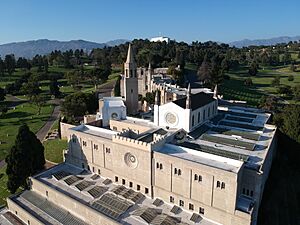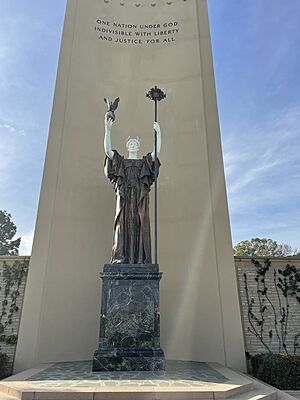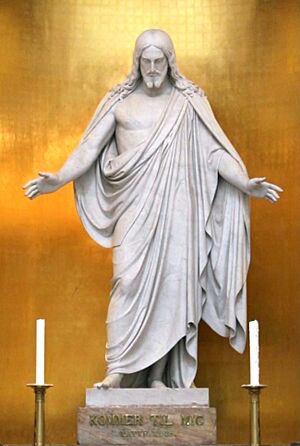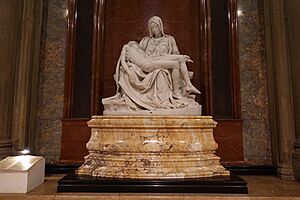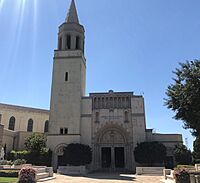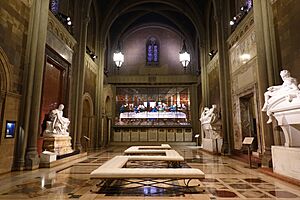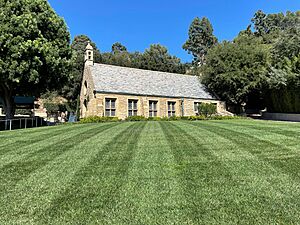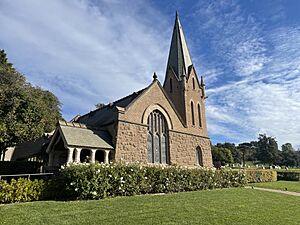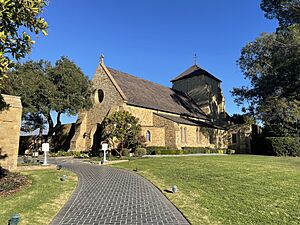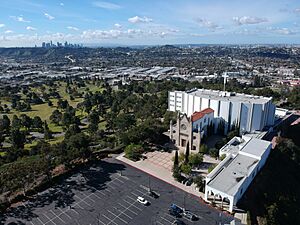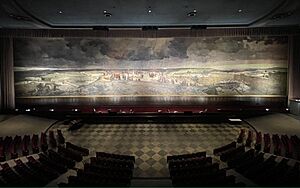Forest Lawn Memorial Park (Glendale) facts for kids
Forest Lawn Memorial Park is a special, privately owned cemetery in Glendale, California, United States. It's the main and first location of Forest Lawn Memorial-Parks & Mortuaries, which is a group of six cemeteries and four other funeral homes in Southern California.
History of Forest Lawn
Forest Lawn Memorial Park started in 1906. It was founded by a group of business people from San Francisco. Later, in 1917, Hubert Eaton took over its management.
Eaton is known as the "Founder" because he had many new ideas. He wanted to make cemeteries feel different. He believed that most cemeteries were "ugly, sad stoneyards." So, he decided to create a beautiful park. This park would have tall trees, green lawns, fountains, and lovely statues. He wanted it to feel like "sunshine" instead of "darkness." He also made it the first place to have a funeral home right inside the cemetery.
Many parts of Forest Lawn have interesting names. Some of these include Eventide, Babyland (for babies, shaped like a heart), Graceland, and Slumberland (for children and teens).
Forest Lawn Museum
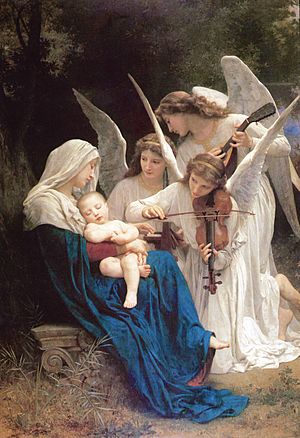
The Forest Lawn Museum in Glendale opened in 1952. It's located next to the Hall of Crucifixion-Resurrection. The museum changes its art exhibitions twice a year. It has shown works by famous artists like Henri Matisse and Rembrandt.
The museum's main art collection includes original bronze and marble sculptures. These are made by artists from Europe and America. It also has beautiful stained glass windows. These windows were once part of William Randolph Hearst's collection. They were made between 1315 and 1575. They show amazing French, German, and Austrian art styles.
Song of the Angels Painting
One of the most famous artworks at the Forest Lawn Museum is a painting called Song of the Angels. It's an oil painting by the French artist William Bouguereau. He painted it in 1881. Bouguereau was a leading French painter in the 1800s.
The painting shows a mother and child sleeping peacefully in a natural setting. Three angels are floating nearby. It's known for its realistic skin tones and soft white colors. Forest Lawn bought this painting in 1940. It was meant for a chapel, and a large wooden frame was built for it.
In 2005, the painting was cleaned at the Getty Center in Los Angeles. Experts carefully removed old layers to bring back its original bright colors.
Statues and Art
The Court of David
The Court of David at Forest Lawn-Glendale features a huge, seventeen-foot-tall copy of Michelangelo Buonarroti's famous David statue. The first copy was put in place in 1939. Sadly, this statue fell during an earthquake in 1971. Parts of it, like the head and foot, are now in the Forest Lawn Museum.
New copies of David were installed later. The most recent bronze copy was placed in 2021. The design of the Court of David was inspired by a square in Florence, Italy, which also has a copy of David.
The Court of Freedom
The Court of Freedom is a large area, about 750 feet long. Its main feature is a huge mosaic picture. This mosaic shows John Trumbull's painting, Signing of the Declaration of Independence.
The mosaic is twenty by thirty feet, which is three times bigger than the original painting. It's made of 700,000 pieces of Venetian glass. These pieces come in more than 1,500 colors! It was specially made in Italy for Forest Lawn.
On each side of the court, there are tall white pillars. One pillar has a copy of The Republic by Daniel Chester French. This statue holds a globe and a staff of liberty. The other pillar has an original statue of George Washington by John Quincy Adams Ward.
Christus
Before World War II, Forest Lawn ordered a copy of Christus. This is an eleven-foot-tall marble sculpture by Bertel Thorvaldsen. The original statue is in Copenhagen, Denmark.
The first large copy arrived in 1940 and was shown in 1946. There are now three copies of Christus spread throughout the cemetery. The Court of The Christus is located above a waterfall.
Great Mausoleum
The Great Mausoleum is a massive building with eleven levels. It has over 100 stained glass windows. This huge structure uses as much steel and concrete as a 70-story skyscraper! It's a mix of different building styles and is a main art spot in the park.
Construction on the mausoleum began in 1917 and was officially opened in 1920. It wasn't fully finished until the 1970s.
The Memorial Court of Honor was opened in 1931. It features a giant stained glass window of the Last Supper. This amazing project took over six years to complete. It was made in Italy and shipped to Glendale.
Inside the Memorial Court of Honor, you can see copies of seven Michelangelo sculptures. This is the only place in the world where you can see excellent marble copies of all of Michelangelo's most famous statues in one spot.
Churches at Forest Lawn
Wee Kirk o' the Heather
The Wee Kirk o' the Heather is the second church built at Forest Lawn. Its design was inspired by a village church in Scotland that was built in 1310. This area of Scotland is famous for writers like Walter Scott and Robert Burns.
The church is also linked to the popular Scottish love song "Annie Laurie." This song tells the story of a woman who lived near the original Scottish church. Her family didn't approve of her marrying a soldier from a different group.
The story of "Annie Laurie" is shown in eight beautiful stained glass windows inside the Wee Kirk at Forest Lawn. The church was opened on October 6, 1929.
Outside the Wee Kirk, there's a "Wishing Chair." It was built in 1931 using stones from the original Scottish church. Legend says that couples who sit in it and say the words carved on it will be blessed forever.
Little Church of the Flowers
The Little Church of the Flowers was the first church built at Forest Lawn. Its architect, T. Patterson Ross, was inspired by an English village church. This English church is where the poet Thomas Gray wrote his famous poem, "Elegy Written in a Country Churchyard." Ross wanted to create a copy of this 600-year-old church.
Flower conservatories were added next to the pews later on. The church was opened on Mother's Day, May 12, 1918. At the end of the church, there's a "Tree of Life Window." Its design came from an old drawing by a monk in an English Abbey.
Church of the Recessional
The Church of the Recessional was the third church built at Forest Lawn. Its design was inspired by the Church of St. Margaret in England. This English church is very old, dating back to 1100 A.D.
The Church of the Recessional was opened on November 30, 1941. Inside, there are three stained glass windows showing scenes of the Virgin Mary and the Christ Child. These windows were made by Charles Jay Connick.
Over the main arch, you can read words from the Bible: "Now abideth faith, hope, and love, these three; and the greatest of these is love." Along one side of the church, there are stained glass windows that show the Beatitudes from the Sermon on the Mount.
In front of the church, there's a romantic "Ring of Aldyth." An old legend says that if a couple holds hands through the ring and repeats the words carved on it, they will find happiness and devotion. The words are: "Thy hand in mine, this ring doth bind, my heart to thine."
Hall of Crucifixion–Resurrection
The Hall of Crucifixion-Resurrection was built to hold a giant painting by Jan Styka called The Crucifixion. The hall's design was inspired by a cathedral in Orvieto, Italy. It has a Gothic style.
The painting is covered by huge curtains that weigh 3,500 pounds! They are 440 feet long and 50 feet high. The hall was finished in three years and opened on March 23, 1951. It's an auditorium for people to view the painting. The wall holding the painting is slightly curved so everyone can see it well.
The painting has an interesting history. The artist, Jan Styka, brought it to the 1904 World's Fair in St. Louis. He couldn't pay to ship it back to Poland, so he left it behind. Styka, who included himself in the painting as the figure of Saul (Paul), died in 1925 without seeing his painting again.
The Crucifixion was rolled up around a telephone pole and stored in warehouses for years. It was found again in 1943. Forest Lawn bought the painting after World War II to show it to the public.
Notable interments
See also
 In Spanish: Forest Lawn Memorial Park (Glendale) para niños
In Spanish: Forest Lawn Memorial Park (Glendale) para niños
- List of cemeteries in the United States


